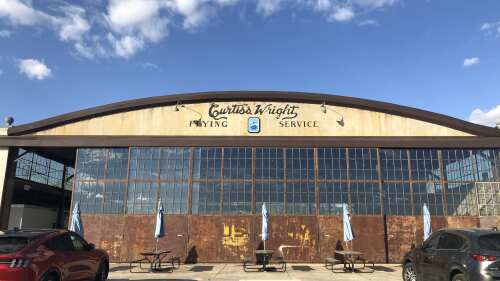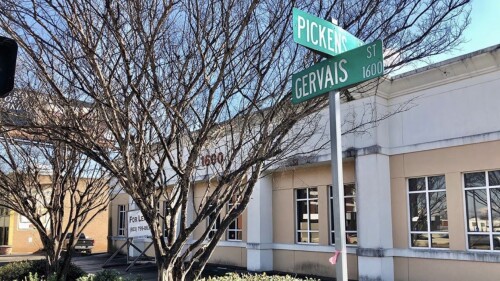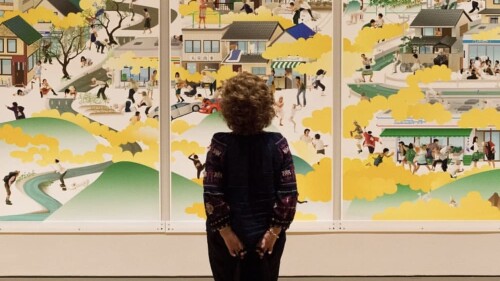This is part of our #TBT series in collaboration with Historic Columbia.
We’re back in action, baby! Did you miss us? Because we missed you. And to make up for it, we’re throwing you a house party.
But it’s not just any house party – it’s Palladium’s Fall Tour. We’re back for a second year in a row and this time, it’s all about Columbia Modern. That’s right, we’ve watched every episode of The Marvelous Mrs. Maisel and are hungry for spam canapés and dry vermouth.
But before you join us for an out-of-this-world Modern homes tour on November 3, we thought we’d write a little field guide to get you started. Read up + impress your Fall Tour friends with your newfound design knowledge.
So load your pockets with martini olives, don your protective booties, and let’s hit the pavement.
What exactly is “Mid-Century Modern”?
Nowadays, we use “Mid-Century Modern” as a catchall term for architecture, furniture, and graphic design from the middle of the 20th century.
But an exact timeframe? That’s tough. If we had to pick a jumping off point – that moment of no return when the world launched into a new era of design – then we would talk about the post-war period.
Why post-WWII? Because technology advanced, air travel brought the world to your doorstep, and the middle class boomed. Gone were the tenuous fears of the Great Depression. The days of rationing and scarcity were a thing of the past. In this post-war economy, everything boomed.
What we might recognize as Mid-Century Modern is really a hodgepodge of elements from different art and architecture movements from the past hundred years. So what you think of as #MCM might not be the real deal. We hate to break it to you, but you’ve been living a lie propagated by West Elm and that guy on eBay who describes those tables he sells as “vintage atomic chic.”
So, when we’re talking about Mid-Century Modern on Palladium’s Columbia Modern tour, we’re really talking about three distinct styles.
1) Contemporary
You may not know its name, but you could probably identify a Contemporary home if you saw one. It’s the type of house every Bond villain owned. BoJack Horseman lives in one. It’s the Jackie Treehorn house from Big Lebowski. Don Draper had his season two crisis on Mad Men in a California Contemporary.
Here are some telltale signs that the house you’re looking at in a Contemporary:
- Contemporaries have asymmetrical facades and use contrasting materials and textures across exterior surfaces. Front doors would often be set to the side or face away from the street. So, if you’re looking at a house with a wide stone chimney, white cladding, and a front door you may not have noticed at first glance, you might be looking at a Contemporary.
- Architects blurred the lines between indoor and outdoor space by using broad, sheltering eaves (that part of the roof that hangs over an exterior wall), walls of windows, and sliding glass doors. Perfect for South Carolina summers when you want to enjoy your backyard without actually being in your backyard.
- Contemporaries tended to be built into their surroundings, instead of on level concrete slabs. Some were built into the sides of hills and supported by stilts.
- Their rooflines have a low pitch or are totally flat. There’s probably a skylight or two if you look hard enough.
Other things you might find in a Contemporary? Open terraces, balconies and decks, pergolas over shaded porches, decorative grilles or screens to enclose carports, roof openings over flower beds near recessed entryways, broad, low masonry chimneys, and Sean Connery.

Wallace-McGee House in Columbia | Image courtesy Russell Maxey Photograph Collection, Richland Library.
2) International
When you hear folks talk about Modern architecture with a capital-M, chances are they’re talking about the International style. Pioneered by French architect Le Corbusier, the International style boils what we know as Modernism down to five signature points:
- Pilotis, which are just unadorned columns. (But “column,” at least according to Corb, is a boring word that pays tribute to the past. So he changed it.) Pilotis lift the building off the ground in order to maximize the usable space on the lot. If you put your house on stilts, then you can park your car – or your airplane, because #modern – underneath.
- A flat rooftop terrace. Because Corbusier thought that, just because you built your house in a city, it didn’t mean that you shouldn’t have a little green space too. And if the underside of your home is being occupied by cars (and Cessnas) why not put a ping pong table on the roof?
- Steel frame construction. Not that you can really tell from the curb, but International houses took advantage of the new technology that was steel. It was strong, so you no longer had to rely on clunky masonry to hold your walls up. Houses could be sleek and sexy.
- Long, horizontal windows known as ribbon windows that often ran around corners and down entire walls. They’re designed to fill your house with that Instagram-friendly natural light and to blur the line between indoors and outdoors. Plus, when your window wraps around the corner of your house, it’s an architect’s way of bragging that they don’t need heavy masonry corners to prevent the roof from collapsing. (Weird flex, but okay.)
- And that most-modern of concepts: the open floorplan. Y’all thought it was invented by HGTV to up the stakes on Love It or List It, didn’t you? Now you know.

Corbusier’s Five Points of a New Architecture via Speculative Cities
3) Atomic Ranch
That’s right, we said it: your mom’s ranch house is Mid-Century chic. Remember earlier when we mentioned the post-war housing boom? Well, the ranch house is what we were talking about. Think about the neighborhoods that are built farther from the grid of downtown Columbia, moving towards Fort Jackson or out past Williams Brice – houses that are low to the ground, built into the landscape, and a front entryway that’s set off to the side.

Ranch home on Lakeshore Dr. | Image courtesy The State Newspaper Photograph Archive, Richland Library.
Here’s how to spot a Ranch house (like you couldn’t already, you clever so-and-so):
- They’re single-story. If you’re looking for a basement to play ping-pong in, we’d recommend you go elsewhere. Ranch houses are low to the ground and don’t feature second stories.
- Attached garages. As folks are starting to be able to afford cars, they want a place to put them. With a ranch house you can park your Chrysler inside the house with the rest of your family.
- Sheltered front entry. The ranch’s front door is almost always obscured in some way. That may mean that it’s simply recessed into the façade of the house, or that a partial-width or enclosed porch separated your front door from the world at large.
- Portrait window! Because where else are you going to put your Christmas tree?
- “Rear yard elaborations.” Which is architecture speak for, “This house has a pool!” Ranch houses typically have rear patios (for backyard BBQs), side porches, verandahs, or below-ground pools. Bonus points if the pool is kidney-shaped.
See you at the afterparty.
If you’re looking for more Mid-Century Modern goodness, we’ve got you covered. Palladium’s annual Fall Tour is just three weeks away. Put your newly minted architectural knowledge to the test on Sunday, November 3.
This signature shindig takes you through five magnificent Mid-Century homes, one iconic office building, and ends with an aviation-themed afterparty at the Hunter Gatherer Hangar. If Midge Maisel taught us anything, it’s that hosting is a serious art—which is why your first beer is on us when you show your Fall Tour wristband. Cheers to that!
Advance tickets are $25 for Palladium members, $30 for Historic Columbia members, and $40 for the general public. Advance ticket sales end Friday, November 1. Any remaining tickets will be available day of at the Historic Columbia Gift Shop for $40, so don’t wait!
It wouldn’t be a #TBT if we didn’t refer you to a podcast. This time, we’re recommending a 99% Invisible episode all about Frank Lloyd Wright’s Usonian houses. You be the judge of which design category they fall under.
That’s it for us this week. We’ll be back soon with Modern Love Part II. In the meantime, grab your ticket to Fall Tour – all the cool kids are doing it.
-Lois, currently on loan to Historic Columbia.














